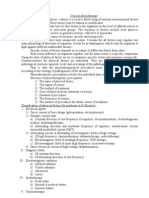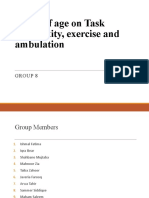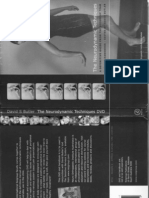0 ratings0% found this document useful (0 votes)
66 viewsGeriatric Rehabilitation
Geriatric Rehabilitation
Uploaded by
Ajay DherwaniGeriatric rehabilitation aims to restore functional ability in elderly patients with impairments through a multidisciplinary approach. The document outlines various biological changes that occur with aging including losses in muscle mass, bone density, and sensory and motor function. Key systems impacted include cardiopulmonary, skin, musculoskeletal, sensory, gastrointestinal and renal/hepatic. A comprehensive geriatric assessment evaluates physical, functional, psychosocial and environmental factors. Common conditions treated include osteoporosis, Parkinson's disease, stroke, falls, incontinence and respiratory issues.
Copyright:
© All Rights Reserved
Available Formats
Download as PDF, TXT or read online from Scribd
Geriatric Rehabilitation
Geriatric Rehabilitation
Uploaded by
Ajay Dherwani0 ratings0% found this document useful (0 votes)
66 views16 pagesGeriatric rehabilitation aims to restore functional ability in elderly patients with impairments through a multidisciplinary approach. The document outlines various biological changes that occur with aging including losses in muscle mass, bone density, and sensory and motor function. Key systems impacted include cardiopulmonary, skin, musculoskeletal, sensory, gastrointestinal and renal/hepatic. A comprehensive geriatric assessment evaluates physical, functional, psychosocial and environmental factors. Common conditions treated include osteoporosis, Parkinson's disease, stroke, falls, incontinence and respiratory issues.
Original Description:
mcqs
Copyright
© © All Rights Reserved
Available Formats
PDF, TXT or read online from Scribd
Share this document
Did you find this document useful?
Is this content inappropriate?
Geriatric rehabilitation aims to restore functional ability in elderly patients with impairments through a multidisciplinary approach. The document outlines various biological changes that occur with aging including losses in muscle mass, bone density, and sensory and motor function. Key systems impacted include cardiopulmonary, skin, musculoskeletal, sensory, gastrointestinal and renal/hepatic. A comprehensive geriatric assessment evaluates physical, functional, psychosocial and environmental factors. Common conditions treated include osteoporosis, Parkinson's disease, stroke, falls, incontinence and respiratory issues.
Copyright:
© All Rights Reserved
Available Formats
Download as PDF, TXT or read online from Scribd
Download as pdf or txt
0 ratings0% found this document useful (0 votes)
66 views16 pagesGeriatric Rehabilitation
Geriatric Rehabilitation
Uploaded by
Ajay DherwaniGeriatric rehabilitation aims to restore functional ability in elderly patients with impairments through a multidisciplinary approach. The document outlines various biological changes that occur with aging including losses in muscle mass, bone density, and sensory and motor function. Key systems impacted include cardiopulmonary, skin, musculoskeletal, sensory, gastrointestinal and renal/hepatic. A comprehensive geriatric assessment evaluates physical, functional, psychosocial and environmental factors. Common conditions treated include osteoporosis, Parkinson's disease, stroke, falls, incontinence and respiratory issues.
Copyright:
© All Rights Reserved
Available Formats
Download as PDF, TXT or read online from Scribd
Download as pdf or txt
You are on page 1of 16
At a glance
Powered by AI
The document discusses geriatric rehabilitation and outlines some of the biological changes that occur with aging, common medical conditions affecting the elderly, and components of evaluating elderly patients.
Some of the physiological changes discussed include changes in body composition with loss of lean tissue and gain of fat, postural changes, cardiopulmonary changes, and sensory changes such as diminished vision and hearing.
Some common conditions mentioned are osteoporosis, Parkinson's disease, stroke, balance and falls issues, and urinary incontinence.
GERIATRIC REHABILITATION
Definition: Geriatric rehabilitation can
can be
be defined
defined
as a multidisciplinary set of evaluations, diagnostic
and therapeutic interventions whose purpose is to
restore functional ability or enhance residual
functional capacity in elderly people with disabling
impairments.
Biology and physiology of aging:
1. Body composition.
2. Postural changes.
3. Cardiopulmonary changes.
4. Skin changes.
5. Hydration.
6. Skeletal muscle changes.
7. Intersystem homeostasis.
8. Sensory changes.
9. Gastrointestinal changes.
10.Renal,
10.Renal, urogenital & hepatic changes.
11.Endocrine
11.Endocrine changes.
1. Body composition:
There is a gradual loss of lean tissue and an
increase in fat.
The loss of lean tissue reflects: loss of muscle
mass, total body muscle mass, limb muscle
volume, muscle cross section area, muscle fiber
numbers and area.
Body fat increases to 30% of body weight at the
age 80 years as compared to 15% at age 30,
which should be taken into account while
prescribing fat soluble drugs.
Bone mineral is lost, peak bone density occurs
in the 30s & 40s & thereafter gradually declines.
2. Postural changes:
Progressive anterior thrust of the head &
extension of the cervical spine.
Accentuated thoracic kyphosis.
Straightening of the lumbar spine.
Increased extension of the arms.
Scapular protraction at shoulders is associated
with flexion of the elbows, ulnar deviation at wrist
& finger flexion.
Increased postural sway occurs with aging.
Ability to balance on one leg either with eyes
open or closed decreases.
Righting reflexes decreases and reaction time
increases.
3. Cardiopulmonary changes:
Cardiac changes that occur with aging
include:
Decrease cardiac reserve.
Decreased contractile function.
Decreased heart rate.
Decreased response to exercise.
Blood pressure tends to rise with aging.
4. Skin changes:
Aging changes that occurs in skin include:
Decreased moisture content.
Decreased epidermal renewal.
Decreased elasticity & blood supply.
Decreased sensitivity to touch, pain &
temperature.
More susceptible to pressure sores and
infection.
Alopecia.
Increased wrinkles.
5. Hydration:
Elderly have approximately 25% decrease in
thrust perception as compared to young.
Medication (diuretics and laxatives) might
increase the elderly persons need for water to
maintain adequate hydration.
Many drugs used by elderly (antidepressants,
analgesics, cancer chemotherapy agents) can
cause the syndrome of inappropriate antidiuretic
hormone secretion and lead to water retention
and hyponatremia.
6. Changes in skeletal muscles:
Reduction in muscle mass.
Reduction in muscle fiber number.
Changes in muscle fiber size (individual fast- fast-
twitch type II muscle fibers decreases with age,
like vastus lateralis, tibialis anterior & biceps
brachii; whereas slow-
slow-twitch
twitch type I fiber does not
change).
Motor unit number & size (there is a decrease in
total number of motor units with age).
7. Intersystem homeostasis:
Thermal regulation: Impaired thermoregulatory
thermoregulatory
mechanisms are more susceptible to
hyperthermia and hypothermia.
Circulation: older person may have
have as
as much
much as
as
20% reduction in cerebral perfusion by the age
of 70.
8. Sensory changes:
Touch ± declines with age.
age.
Vision ± blurring of vision, eyelid
eyelid wrinkles,
wrinkles,
diminished tear production.
Hearing ± sensorineural hearing
hearing loss
loss
(presbycusis).
Proprioception/kinesthesia.
Vestibular system.
Taste & smell ± becomes less acute with
with age.
age.
9. Gastrointestinal Changes:
Intermaxillary spaces reduces.
Tooth pulp may atrophy and regress.
Esophagus- decreased mobility and
Esophagus- and decreased
decreased
sphincter relaxation with swallowing
(presbyesophagus).
Diverticulosis- immobile/dehydration leads
Diverticulosis- leads to
to
constipation leads to fecal impaction & bowel
obstruction leads to diverticulosis.
10. Renal, Urogenital & Hepatic
changes:
Liver mass and blood perfusion decrease with
age.a
Biliary stones incidence increases.
Efficiency of cholesterol stabilization in body
decreases.
Decrease in kidney mass and weight reduction
in glomerular capillary loops.
Glomerular filtration rate decreases.
Renal tubules
tubules-- decrease in excretory
excretory and
and
reabsorptive capacities.
Urinary bladder
bladder-- increased uninhibited
uninhibited
contractions, residual urine & bacteriuria.
11. Endocrine changes:
Three hormones show decrease in circulating
hormone concentrations during aging:
Andropause-- decrease in gonadal
Andropause gonadal function
function in
in
men.
Adrenopause-- prepubertal increase
Adrenopause increase in
in adrenal
adrenal
secretion of DHEA.
Somatopause- decrease in function of
Somatopause- of growth
growth
hormone releasing, growth hormone insulin ±like
±like
growth factor.
EVALUATION & ASSESSMENT
Assessment of an elder can be divided into
following headings:
Physical and functional assessment.
Pain assessment.
Environment assessment.
Psychosocial assessment.
REHABILITATION OF ELDERLY
Most common conditions encountered by elderly
OSTEOPOROSIS.
PARKINSON¶S DISEASE.
STROKE MANAGEMENT.
BALANCE AND FALLS.
URINARY INCONTINENCE.
IMPAIRED RESPIRATION AND VENTILATION.
POSTURE.
Thank you..
You might also like
- Orthopedics Hyperguide MCQDocument1,445 pagesOrthopedics Hyperguide MCQAnonymous 43mqs5pElf100% (21)
- Ota VolleyballDocument48 pagesOta VolleyballFANTAZTIC FITNEZZ100% (2)
- Peat 4Document41 pagesPeat 4Steve Colbert100% (4)
- Post Operative Physiotherapy Management For Flail ChestDocument67 pagesPost Operative Physiotherapy Management For Flail Chestsohini bhattacharyaNo ratings yet
- Adult Psychiatric Sensory Integration EvaluationDocument18 pagesAdult Psychiatric Sensory Integration Evaluationemesep1867% (3)
- Neurological Physical TherapyDocument3 pagesNeurological Physical TherapyDr.Jamal ShahNo ratings yet
- The Cyriax Method of MSK Examination ROMDocument78 pagesThe Cyriax Method of MSK Examination ROMMittulNo ratings yet
- Traction and Orthopaedic AppliancesDocument1 pageTraction and Orthopaedic Appliancesmanmohansai bacheNo ratings yet
- Cotton OsteotomyDocument16 pagesCotton OsteotomybaoNo ratings yet
- Diaphragmatic ParalysisDocument32 pagesDiaphragmatic ParalysisSwapnil MehtaNo ratings yet
- Anatomical Positions & Body MovementsDocument29 pagesAnatomical Positions & Body MovementsWilbert Antonino Cabanban100% (1)
- Paget Disease of Bone, A Simple Guide to the Condition, Treatment and Related DiseasesFrom EverandPaget Disease of Bone, A Simple Guide to the Condition, Treatment and Related DiseasesNo ratings yet
- Physiotherapy For Plantar Fasciitis - A UK Wide Survey of Current PracticeDocument29 pagesPhysiotherapy For Plantar Fasciitis - A UK Wide Survey of Current PracticeCambriaChicoNo ratings yet
- Volkmann's Ischemic Contracture by Innocent C. AbuguDocument38 pagesVolkmann's Ischemic Contracture by Innocent C. AbuguChukwuemeka ChidogoNo ratings yet
- Case Report Rehabilitation Program in A Patient With A Displaced Femoral Neck FractureDocument26 pagesCase Report Rehabilitation Program in A Patient With A Displaced Femoral Neck FractureNatalia LoredanaNo ratings yet
- Clinical Orthopaedics: August 2011Document15 pagesClinical Orthopaedics: August 2011Tarun Singh SinghNo ratings yet
- Facial Nerve Palsy: Dr. Saud AlromaihDocument74 pagesFacial Nerve Palsy: Dr. Saud AlromaihChandra ManapaNo ratings yet
- Open MPT 2020-21 Syllabus NewDocument90 pagesOpen MPT 2020-21 Syllabus NewsmrutiptNo ratings yet
- The Timed Up & Go - A Test of Basic Functional Mobility For Frail Elderly Persons. lAGSDocument7 pagesThe Timed Up & Go - A Test of Basic Functional Mobility For Frail Elderly Persons. lAGSJose Fernando Díez ConchaNo ratings yet
- Nepal Health Professional Council: Syllabus For Licensing Examination of Certificate in Physiotherapy 2021Document4 pagesNepal Health Professional Council: Syllabus For Licensing Examination of Certificate in Physiotherapy 2021HariNo ratings yet
- Assignments: WHICH TEST? Assignement One: Choose The Appropriate Statistical Test To Address Each of The Following Research QuestionsDocument3 pagesAssignments: WHICH TEST? Assignement One: Choose The Appropriate Statistical Test To Address Each of The Following Research QuestionsghallabNo ratings yet
- Lesson 8 Brunn Le BobathDocument24 pagesLesson 8 Brunn Le BobathMira AurumtinNo ratings yet
- Physiotherapy: Model Question PapersDocument16 pagesPhysiotherapy: Model Question PapersguruyasNo ratings yet
- 4954thoracic TraumaDocument43 pages4954thoracic TraumaSahilSharmaNo ratings yet
- ROM Booklet 07nov2010Document26 pagesROM Booklet 07nov2010his.thunder122No ratings yet
- Orthopedics Exam 3Document27 pagesOrthopedics Exam 3Sarhan AliNo ratings yet
- AchillesDocument35 pagesAchillesNindy100% (1)
- 6 Minute Walk TestDocument2 pages6 Minute Walk TestErvina Hesti Utami EliasNo ratings yet
- RS2480 Amputation 2018Document49 pagesRS2480 Amputation 2018Hung Sarah100% (1)
- Reads Past Papers Solved ........ DR Mazhar AbbasDocument22 pagesReads Past Papers Solved ........ DR Mazhar AbbasMohammad Ajmal MadniNo ratings yet
- Physiotherapy Secrets: Multiple Choice QuestionsDocument2 pagesPhysiotherapy Secrets: Multiple Choice QuestionsMohammad shahrukh khan100% (1)
- Physiotherapy Guidelines For Manual HyperinflationDocument5 pagesPhysiotherapy Guidelines For Manual HyperinflationAhmed Abd Elrauf100% (2)
- BPT Syllabus As On 5th Jan 19Document134 pagesBPT Syllabus As On 5th Jan 19jay shahNo ratings yet
- RSPT 427 - Integumentary ConditionsDocument4 pagesRSPT 427 - Integumentary ConditionsNestor BalboaNo ratings yet
- General PhysiotherapyDocument6 pagesGeneral Physiotherapysomebody_maNo ratings yet
- Leg Ankle Orthopaedic Conditions FinalDocument26 pagesLeg Ankle Orthopaedic Conditions Finalangel bolfriNo ratings yet
- 01 Musculoskeletal AssessmentDocument10 pages01 Musculoskeletal Assessment楊畯凱100% (2)
- Effect of Age On Task Complexity, Exercise and Ambulation: Group 8Document17 pagesEffect of Age On Task Complexity, Exercise and Ambulation: Group 8PreciousShaizNo ratings yet
- Monograph PHYSIOTHERAPY IN ONCOLOGYDocument28 pagesMonograph PHYSIOTHERAPY IN ONCOLOGYScribdTranslations100% (1)
- Writing Knee OsteoarthritisDocument58 pagesWriting Knee OsteoarthritisHanani KamaludinNo ratings yet
- THRDocument83 pagesTHRDanes PaguioNo ratings yet
- Chapter 13 Petty Musculoskeletal Examination and AssessmentDocument2 pagesChapter 13 Petty Musculoskeletal Examination and AssessmentRohmat ChrNo ratings yet
- Sensory Motor Approaches: Brunstrom TheoryDocument32 pagesSensory Motor Approaches: Brunstrom TheoryAsaad JawedNo ratings yet
- Orthotics Consensus Conference ReportDocument354 pagesOrthotics Consensus Conference ReportAlec joshua RapadaNo ratings yet
- SportDocument2 pagesSportrima rizky nourliaNo ratings yet
- PT in Geriatric ConditionsDocument12 pagesPT in Geriatric ConditionsJiggs LimNo ratings yet
- Pathological ReflexesDocument2 pagesPathological ReflexesNilo Carmelo LumanogNo ratings yet
- Anatomy - Evals 01Document22 pagesAnatomy - Evals 01Joey RosalesNo ratings yet
- Diagnosis of Ear PainDocument8 pagesDiagnosis of Ear PainJoyce TeoNo ratings yet
- Introduction of Physical MedicineDocument39 pagesIntroduction of Physical MedicineDrMd Nurul Hoque MiahNo ratings yet
- Prevention Practice For Neuromuscular ConditionsDocument37 pagesPrevention Practice For Neuromuscular ConditionsArham ShamsiNo ratings yet
- Upper Limb Orthosis - Dr. Bhaskarananda KumarDocument33 pagesUpper Limb Orthosis - Dr. Bhaskarananda KumarsudiptomukherjeeNo ratings yet
- Knee Biomechanics: Mark Arthur Martinez Trauma 1 April 5, 2018Document7 pagesKnee Biomechanics: Mark Arthur Martinez Trauma 1 April 5, 2018Juan Alvaro EstradaNo ratings yet
- Quiz IVDocument5 pagesQuiz IVErvin T MileNo ratings yet
- Written Assessment Information Booklet Website July 2018Document11 pagesWritten Assessment Information Booklet Website July 2018Shaheen Abdul QaderNo ratings yet
- GlenoidQauntification PDFDocument6 pagesGlenoidQauntification PDFnacho InfanteNo ratings yet
- ASSESMENT Cardiorespiratory FitnessDocument40 pagesASSESMENT Cardiorespiratory Fitnessmsalungin1313No ratings yet
- Roles of Rehab in Wound CareDocument83 pagesRoles of Rehab in Wound Careanon_416792419No ratings yet
- Musculoskeletal RehabilitationDocument25 pagesMusculoskeletal RehabilitationNadia Ayu TiarasariNo ratings yet
- Physical Examination of The Critically Injured AthleteDocument19 pagesPhysical Examination of The Critically Injured AthleteAyesha LatifNo ratings yet
- Sanjivani CPR and ECC TrainingDocument134 pagesSanjivani CPR and ECC TrainingVaishakh ShyamNo ratings yet
- Brachial PlexusDocument23 pagesBrachial PlexusChristone “Zuluzulu” Zulu100% (1)
- Interferential Therapy Sept 08Document8 pagesInterferential Therapy Sept 08api-19753815100% (1)
- Basic Electronics IIDocument138 pagesBasic Electronics IIAjay DherwaniNo ratings yet
- Curriculum Integration From Ladder To LudoDocument4 pagesCurriculum Integration From Ladder To LudoAjay DherwaniNo ratings yet
- Diseases of The CurriculumDocument8 pagesDiseases of The CurriculumAjay DherwaniNo ratings yet
- Heliotherapy 121003100409 Phpapp02Document26 pagesHeliotherapy 121003100409 Phpapp02Ajay DherwaniNo ratings yet
- Continuous Passive MotionDocument9 pagesContinuous Passive MotionAjay DherwaniNo ratings yet
- Kirchoff LawsDocument31 pagesKirchoff LawsAjay DherwaniNo ratings yet
- Abdominal Pain DR - Shaesta.TabassumDocument45 pagesAbdominal Pain DR - Shaesta.TabassumAjay DherwaniNo ratings yet
- Secondary Survey: DR - Shaesta TabassumDocument38 pagesSecondary Survey: DR - Shaesta TabassumAjay DherwaniNo ratings yet
- Shortness of Breath: ER Perspective Shaesta TabassumDocument46 pagesShortness of Breath: ER Perspective Shaesta TabassumAjay DherwaniNo ratings yet
- Of The Multiply Injured PatientDocument29 pagesOf The Multiply Injured PatientAjay DherwaniNo ratings yet
- Management of Diabetic KetoacidosisDocument23 pagesManagement of Diabetic KetoacidosisAjay DherwaniNo ratings yet
- Proprioceptive Neuromuscular Facilitation - TECHNIQUESDocument52 pagesProprioceptive Neuromuscular Facilitation - TECHNIQUESDharam Pandey100% (3)
- The Best Push Pull Legs Routine For Muscle Growth (Based On Science)Document1 pageThe Best Push Pull Legs Routine For Muscle Growth (Based On Science)aaronlumbaospanishNo ratings yet
- Mime WorkshopDocument17 pagesMime WorkshopPhillarts LopesNo ratings yet
- Pathfit-Reviewer 2Document4 pagesPathfit-Reviewer 2John Mharco ArcillaNo ratings yet
- 2018 Friday Cal Dietz PDFDocument41 pages2018 Friday Cal Dietz PDFMolli100% (1)
- Anatomy Final All Questions (New)Document175 pagesAnatomy Final All Questions (New)Sevval OzcelikNo ratings yet
- CAPIRAL Exercise 10 Joints and Body MovementsDocument3 pagesCAPIRAL Exercise 10 Joints and Body MovementsGeorge ParkNo ratings yet
- Assistive DevicesDocument11 pagesAssistive Devicesshifali guptaNo ratings yet
- RULA - A Survey Method For The Investigation of Work-Related Upper Limb Disorders PDFDocument10 pagesRULA - A Survey Method For The Investigation of Work-Related Upper Limb Disorders PDFAchmad SyukronNo ratings yet
- Fractures OF THE Radius AND Ulna : Mervyn Evans, SwanseaDocument14 pagesFractures OF THE Radius AND Ulna : Mervyn Evans, SwanseaErvan SuryantiNo ratings yet
- Training Body Weight Support: Weight: HemipareticDocument6 pagesTraining Body Weight Support: Weight: HemipareticCosmin CosNo ratings yet
- 2018 Impairment GuidelinesDocument64 pages2018 Impairment GuidelinesMarco Antonio Borges das NevesNo ratings yet
- Class 12 Physical EducationDocument712 pagesClass 12 Physical EducationCBSE UGC NET EXAMNo ratings yet
- Volleyball: Skills in PlayingDocument28 pagesVolleyball: Skills in PlayingFria Mae Aycardo AbellanoNo ratings yet
- Manejo y Cuidados Aves ArticulosDocument318 pagesManejo y Cuidados Aves ArticulosjalexanderfrancoNo ratings yet
- Kinesiology Wrist and HandDocument61 pagesKinesiology Wrist and HandBobby YandhikaNo ratings yet
- Care of The NewbornDocument10 pagesCare of The NewbornValarmathi0% (1)
- Nautilus Strength Catalog RevisedDocument51 pagesNautilus Strength Catalog RevisedMario Lamberti100% (1)
- Anatomy, Physiology, KinesiologyDocument442 pagesAnatomy, Physiology, KinesiologyFloriza de Leon100% (5)
- ANATOMY AND PHYSIOLOGY ReviewerDocument11 pagesANATOMY AND PHYSIOLOGY ReviewerMarmie Babaran GallibuNo ratings yet
- RN Fundamentals of NursingDocument325 pagesRN Fundamentals of NursingChin Chan80% (10)
- Butler - Neurodynamic TechniquesDocument55 pagesButler - Neurodynamic Techniquesmszlazak4179100% (5)
- Unit 2.2 (Complete)Document11 pagesUnit 2.2 (Complete)Génesis DuránNo ratings yet
- The Neurological ExaminationDocument28 pagesThe Neurological ExaminationpremaNo ratings yet
- United States Department of The Interior: National Park ServiceDocument25 pagesUnited States Department of The Interior: National Park ServiceChau HaiNo ratings yet




































































































